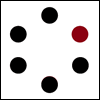Journal of the American Chemical Society, volume 130, issue 44, pages 14891-14899
Enantioselective Iridium-Catalyzed Carbonyl Allylation from the Alcohol or Aldehyde Oxidation Level via Transfer Hydrogenative Coupling of Allyl Acetate: Departure from Chirally Modified Allyl Metal Reagents in Carbonyl Addition
Publication type: Journal Article
Publication date: 2008-10-08
Q1
Q1
SJR: 5.489
CiteScore: 24.4
Impact factor: 14.4
ISSN: 00027863, 15205126
PubMed ID:
18841896
General Chemistry
Catalysis
Biochemistry
Colloid and Surface Chemistry
Abstract
Under the conditions of transfer hydrogenation employing an iridium catalyst generated in situ from [Ir(cod)Cl]2, chiral phosphine ligand (R)-BINAP or (R)-Cl,MeO-BIPHEP, and m-nitrobenzoic acid, allyl acetate couples to allylic alcohols 1a−c, aliphatic alcohols 1d−l, and benzylic alcohols 1m−u to furnish products of carbonyl allylation 3a−u with exceptional levels of asymmetric induction. The very same set of optically enriched carbonyl allylation products 3a−u are accessible from enals 2a−c, aliphatic aldehydes 2d−l, and aryl aldehydes 2m−u, using iridium catalysts ligated by (−)-TMBTP or (R)-Cl,MeO-BIPHEP under identical conditions, but employing isopropanol as a hydrogen donor. A catalytically active cyclometallated complex V, which arises upon ortho-C−H insertion of iridium onto m-nitrobenzoic acid, was characterized by single-crystal X-ray diffraction. The results of isotopic labeling are consistent with intervention of symmetric iridium π-allyl intermediates or rapid interconversion of σ-allyl haptomers through the agency of a symmetric π-allyl. Competition experiments demonstrate rapid and reversible hydrogenation−dehydrogenation of the carbonyl partner in advance of C−C coupling. However, the coupling products, which are homoallylic alcohols, experience very little erosion of optical purity by way of redox equilibration under the coupling conditions, although isopropanol, a secondary alcohol, may serve as terminal reductant. A plausible catalytic mechanism accounting for these observations is proposed, along with a stereochemical model that accounts for the observed sense of absolute stereoinduction. This protocol for asymmetric carbonyl allylation transcends the barriers imposed by oxidation level and the use of preformed allyl metal reagents.
Found
Found
Top-30
Journals
|
5
10
15
20
25
30
35
40
45
|
|
|
Journal of the American Chemical Society
42 publications, 15.73%
|
|
|
Organic Letters
39 publications, 14.61%
|
|
|
Angewandte Chemie
25 publications, 9.36%
|
|
|
Angewandte Chemie - International Edition
25 publications, 9.36%
|
|
|
Chemical Communications
12 publications, 4.49%
|
|
|
Journal of Organic Chemistry
11 publications, 4.12%
|
|
|
Chemical Reviews
10 publications, 3.75%
|
|
|
ACS Catalysis
8 publications, 3%
|
|
|
Chemistry - A European Journal
8 publications, 3%
|
|
|
Tetrahedron
5 publications, 1.87%
|
|
|
European Journal of Organic Chemistry
4 publications, 1.5%
|
|
|
Advanced Synthesis and Catalysis
4 publications, 1.5%
|
|
|
Chemical Science
4 publications, 1.5%
|
|
|
Synthesis
4 publications, 1.5%
|
|
|
Organic and Biomolecular Chemistry
3 publications, 1.12%
|
|
|
Bulletin of the Chemical Society of Japan
2 publications, 0.75%
|
|
|
Tetrahedron Letters
2 publications, 0.75%
|
|
|
Chem
2 publications, 0.75%
|
|
|
Chemistry - An Asian Journal
2 publications, 0.75%
|
|
|
Organic Process Research and Development
2 publications, 0.75%
|
|
|
Organometallics
2 publications, 0.75%
|
|
|
Accounts of Chemical Research
2 publications, 0.75%
|
|
|
Chemical Society Reviews
2 publications, 0.75%
|
|
|
Chinese Journal of Organic Chemistry
1 publication, 0.37%
|
|
|
Marine Drugs
1 publication, 0.37%
|
|
|
Yuki Gosei Kagaku Kyokaishi/Journal of Synthetic Organic Chemistry
1 publication, 0.37%
|
|
|
Science China Chemistry
1 publication, 0.37%
|
|
|
Nature Chemistry
1 publication, 0.37%
|
|
|
Beilstein Journal of Organic Chemistry
1 publication, 0.37%
|
|
|
5
10
15
20
25
30
35
40
45
|
Publishers
|
20
40
60
80
100
120
|
|
|
American Chemical Society (ACS)
118 publications, 44.19%
|
|
|
Wiley
85 publications, 31.84%
|
|
|
Royal Society of Chemistry (RSC)
24 publications, 8.99%
|
|
|
Elsevier
15 publications, 5.62%
|
|
|
Springer Nature
5 publications, 1.87%
|
|
|
Georg Thieme Verlag KG
5 publications, 1.87%
|
|
|
Oxford University Press
2 publications, 0.75%
|
|
|
Shanghai Institute of Organic Chemistry
1 publication, 0.37%
|
|
|
MDPI
1 publication, 0.37%
|
|
|
The Society of Synthetic Organic Chemistry, Japan
1 publication, 0.37%
|
|
|
Beilstein-Institut
1 publication, 0.37%
|
|
|
The Japan Institute of Heterocyclic Chemistry
1 publication, 0.37%
|
|
|
Autonomous Non-profit Organization Editorial Board of the journal Uspekhi Khimii
1 publication, 0.37%
|
|
|
20
40
60
80
100
120
|
- We do not take into account publications without a DOI.
- Statistics recalculated only for publications connected to researchers, organizations and labs registered on the platform.
- Statistics recalculated weekly.
Are you a researcher?
Create a profile to get free access to personal recommendations for colleagues and new articles.
Metrics
Cite this
GOST |
RIS |
BibTex |
MLA
Cite this
GOST
Copy
Kim I. S., Ngai M. Yu., Krische M. J. Enantioselective Iridium-Catalyzed Carbonyl Allylation from the Alcohol or Aldehyde Oxidation Level via Transfer Hydrogenative Coupling of Allyl Acetate: Departure from Chirally Modified Allyl Metal Reagents in Carbonyl Addition // Journal of the American Chemical Society. 2008. Vol. 130. No. 44. pp. 14891-14899.
GOST all authors (up to 50)
Copy
Kim I. S., Ngai M. Yu., Krische M. J. Enantioselective Iridium-Catalyzed Carbonyl Allylation from the Alcohol or Aldehyde Oxidation Level via Transfer Hydrogenative Coupling of Allyl Acetate: Departure from Chirally Modified Allyl Metal Reagents in Carbonyl Addition // Journal of the American Chemical Society. 2008. Vol. 130. No. 44. pp. 14891-14899.
Cite this
RIS
Copy
TY - JOUR
DO - 10.1021/ja805722e
UR - https://doi.org/10.1021/ja805722e
TI - Enantioselective Iridium-Catalyzed Carbonyl Allylation from the Alcohol or Aldehyde Oxidation Level via Transfer Hydrogenative Coupling of Allyl Acetate: Departure from Chirally Modified Allyl Metal Reagents in Carbonyl Addition
T2 - Journal of the American Chemical Society
AU - Kim, In Su
AU - Ngai, Ming Yu
AU - Krische, Michael J
PY - 2008
DA - 2008/10/08
PB - American Chemical Society (ACS)
SP - 14891-14899
IS - 44
VL - 130
PMID - 18841896
SN - 0002-7863
SN - 1520-5126
ER -
Cite this
BibTex (up to 50 authors)
Copy
@article{2008_Kim,
author = {In Su Kim and Ming Yu Ngai and Michael J Krische},
title = {Enantioselective Iridium-Catalyzed Carbonyl Allylation from the Alcohol or Aldehyde Oxidation Level via Transfer Hydrogenative Coupling of Allyl Acetate: Departure from Chirally Modified Allyl Metal Reagents in Carbonyl Addition},
journal = {Journal of the American Chemical Society},
year = {2008},
volume = {130},
publisher = {American Chemical Society (ACS)},
month = {oct},
url = {https://doi.org/10.1021/ja805722e},
number = {44},
pages = {14891--14899},
doi = {10.1021/ja805722e}
}
Cite this
MLA
Copy
Kim, In Su, et al. “Enantioselective Iridium-Catalyzed Carbonyl Allylation from the Alcohol or Aldehyde Oxidation Level via Transfer Hydrogenative Coupling of Allyl Acetate: Departure from Chirally Modified Allyl Metal Reagents in Carbonyl Addition.” Journal of the American Chemical Society, vol. 130, no. 44, Oct. 2008, pp. 14891-14899. https://doi.org/10.1021/ja805722e.














